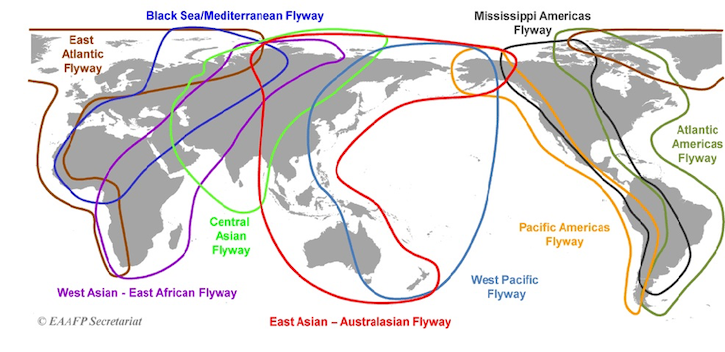
By Dr. Lew Young
The Paulson Institute (PI) became an official partner of the East Asian-Australasian Flyway Partnership (EAAFP) on December 10, joining 36 governments, international organizations, NGOs and private enterprises in a coalition committed to protecting migratory waterbirds, their habitats and the livelihoods of people dependent upon them.
The East Asian-Australasian Flyway (EAAF) is one of nine major globally recognized routes for migratory birds, stretching from the Russian Far East and Alaska, southwards through East Asia and Southeast Asia, to Australia and New Zealand. It is home to over 50 million migratory waterbirds such as shorebirds, ducks, geese, swans, cranes and seabirds, including 32 globally threatened species and 19 near threatened species.

During their arduous migration, waterbirds rely on a system of highly productive wetlands to rest and feed, building up sufficient energy to fuel the next phase of their journey. Along the EAAF, there are over 1,000 sites recognised as internationally important to migratory waterbirds, of which 137 are officially designated as Flyway Network Sites. Nineteen of these are in China, highlighting the importance of China’s coastal wetlands in providing many birds the only stop on their journeys from the Southern Hemisphere to Arctic breeding grounds and back again. Furthermore, these wetlands are not only important for migratory birds but also for the beneficial ‘ecosystem services’ they provide to people.

Over the last few years, PI has made a vital and timely contribution to the aims of the EAAFP. In 2015 PI published the landmark “Coastal Wetlands Blueprint”, produced in partnership with the Management Office of the People’s Republic of China for the Convention on Wetlands under the State Forestry Administration (now the National Forestry and Grassland Administration) and the Institute of Geographic Sciences and Natural Resources Research (IGSNRR) under the Chinese Academy of Sciences (CAS), and funded by the LaoNiu Foundation. The Blueprint showed that China’s coastal wetlands, despite representing only 0.6 percent of the total land area in China, offered ecosystem services valued at USD200 billion annually, or 16 percent of the total ecosystem service values in the country.
These benefits include improving water quality, flood control and disaster reduction, mitigating storm tides and typhoons, providing favorable natural conditions, and protecting the safety of facilities and people in coastal zones. In addition, coastal zones and offshore waters were found to provide key breeding sites for fish, as well as critical areas to maintain marine fish diversity.
Until recently, these benefits were not being taken into account by decision-makers and, consequently, about 60% of intertidal mudflats along China’s coast have been lost to development over the last few decades.
The publication of the Blueprint with its compelling recommendations inspired action. The Chinese government announced in February 2017 that it would add a series of sites along the Yellow Sea and Bohai Bay to a tentative list of application sites for World Heritage status. While there remains a long process to secure formal nomination and inscription onto the list of World Heritage Sites, inclusion on the application list is an important statement from the Chinese government about the value of coastal wetlands.

More progress followed in July 2018 when the State Council announced a ban on commercial land reclamation along China’s coast. This powerful signal from the highest levels of China’s government provided a significant boost to the future of migratory waterbirds, their habitats and the people that depend on them.
Crucially, this high-level announcement is spurring action at the provincial and municipal levels. The acting mayor of Yancheng city in Jiangsu province, home to a significant site along China’s coast, announced in November that the city would expand the area covered by the tentative nomination for World Heritage status to include some of the most important sites for the critically endangered Spoon-billed Sandpiper (Calidris pygmaea), such as Taozini and Dongsha Shoals.
By providing evidenced-based recommendations so that policymakers can make informed planning decisions, PI is contributing greatly toward achieving the aims of the EAAFP. Furthermore, the Blueprint’s influence extends far beyond China’s borders, as many of its conclusions and recommendations apply to coastal wetlands in other countries along the Flyway.
International cooperation across the Flyway is essential to conserve and protect migratory waterbirds and the habitats on which they depend. The Blueprint, ongoing fieldwork at critical sites, capacity building for coastal wetland managers and education for the public make PI a welcome and worthy addition to the Partnership.
 Dr. Lew Young is Chief Executive, East Asian-Australasian Flyway Partnership
Dr. Lew Young is Chief Executive, East Asian-Australasian Flyway Partnership


